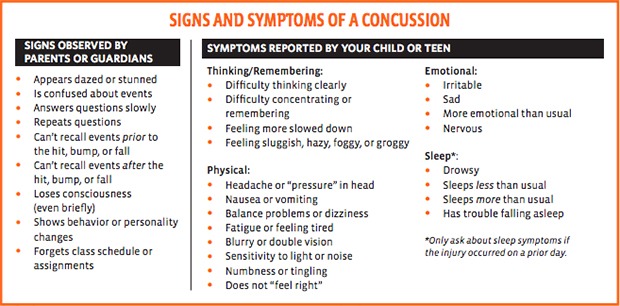Concussion
The Centers for Disease Control and Prevention (CDC) defines a concussion as:
A concussion is a type of traumatic brain injury- or TBI- caused by a bump, blow, or jolt to the head or by a hit to the body that causes the head and brain to move rapidly back and forth. This sudden movement can cause the brain to bounce around or twist in the skull, stretching and damaging the brain cells and creating chemical changes in the brain.
It is important to recognize that concussions can be sustained through a variety of means including: motor vehicle crashes, falls, bicycle accidents, recreational mishaps, etc. A child/adolescent does not need to experience loss of consciousness to sustain a concussion. The signs and symptoms of a concussion can be found in the CDC chart below.
Your student’s school has a team to help manage your child while they are at school following a concussion. It is important for your student to return to school as soon as they can even with tolerable symptoms to help avoid feeling of isolation, depression and anxiety. Your child does NOT need medical clearance to return back to school.
Concussion Videos:
- Children’s Hospital Colorado “What it’s like to get a concussion”
- Concussion Management: A Team Approach
Colorado Legislation:
- Senate Bill 11-040 “The Jake Snakenberg Youth Concussion Act” went into effect on January 1, 2012.
- May 3, 2019 Amendment to “The Jake Snakenberg Youth Concussion Act” – see Section 1, 25-43-102(1)(e).
Materials on Concussion Management:
- Colorado Department of Education: Concussion Management Guidelines
- Get Schooled on Concussion: Return to Learn
- Colorado Youth Concussion Education Consortium: Managing Concussions in PracticeBrain Line for Kids: Concussion
